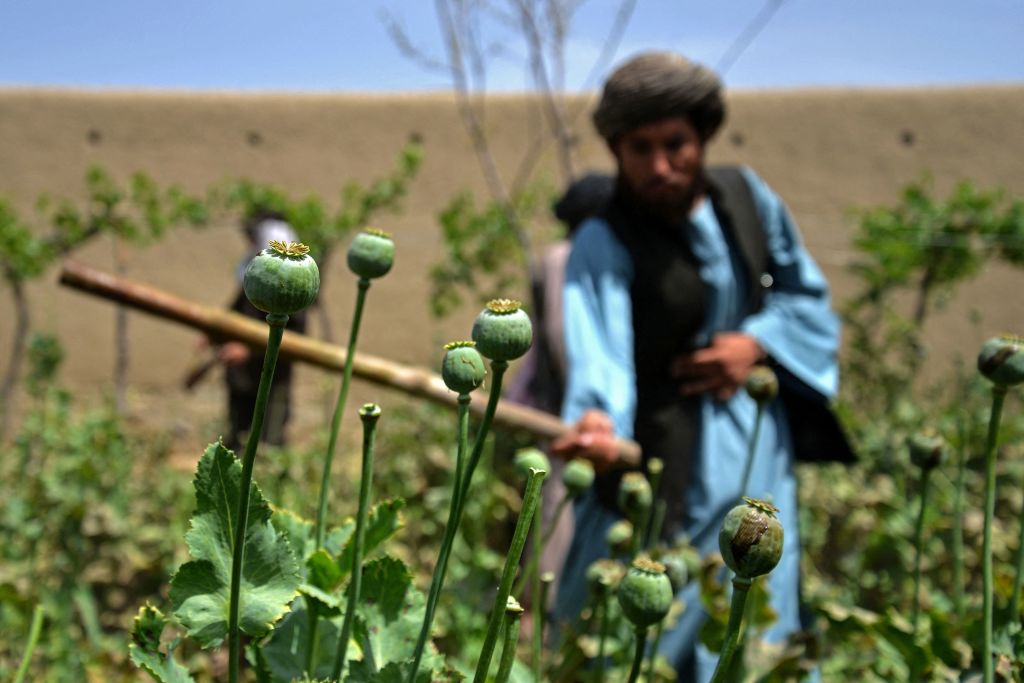
For years, the international community tried and failed to rein in Afghanistan’s drug economy, which in 2021 amounted to at least 14% of the country’s GDP. But the Taliban, which swept into power that August after the U.S. withdrawal, appears to have now suppressed opium poppy cultivation by almost 90%. On the surface, that is a remarkable development. Vast, illegal drug production amplifies corruption, predatory rapaciousness, and lawlessness helped bring down the U.S.-backed Afghan Republic, not to mention setting off high addiction rates. But suppressing opium production without offering economic alternatives creates grave socioeconomic harms to the already suffering Afghan people. And it is setting up the world for far worse public health consequences.
According to David Mansfield of consulting firm Alcis, the Taliban’s enforcement of its 2021 ban on drug production more or less wiped out poppy cultivation in Helmand and Nangahar, two major production areas. The countrywide decline seems to be on par with the Taliban’s highly effective poppy ban in 2000. And just like then, the economic and social consequences of the ban are severe.
The Taliban has been remarkably effective in maintaining brisk trade and crucial minerals exports, stabilizing the Afghan economy, significantly reducing corruption in taxes and customs, and generating some $2 billion in yearly revenues—the same as what the Afghan Republic did under far more generous international circumstances. But according to Mansfield’s estimates, the current opium ban has cost the Afghan economy $1.3 billion and 450,000 jobs at the farm-level alone, and that doesn’t include the high economic losses downstream. What’s more, most of the Taliban’s budget is used to fund its military and security apparatus, leaving little for the Afghan people. As the economist Bill Byrd puts it, the Taliban’s economic stabilization is one of a “famine equilibrium.” With 90% of the population stuck in poverty, what has kept Afghans from starving is humanitarian aid. Yet that aid has been rapidly declining this year—by at least $1 billion out of the $3 billion provided in 2022.
More from TIME
Those who lost their opium livelihoods mostly cannot find economic alternatives to feed their families, including in the security services, as they used to during the Afghan Republic. Wheat has never been a good replacement crop, and the economy in Afghan cities is down as well. Essentially, once stocks from the summer 2022 opium bumper crop that the Taliban allowed to be harvested runs out, many households will experience dramatic declines in their ability to buy food, rent land, maintain housing, and receive medical care. As with prior opium bans in Afghanistan, many households will fall even deeper into debt and be forced to marry off their daughters at an extremely young age. Migration out of Afghanistan will ramp up.
Read More: Far From Home
Opposition to maintaining the ban into a second and perhaps third year will likely grow, including among the Taliban’s key constituencies, such as landed households in the country’s majority Pashtun areas and among Taliban commanders. Many of them have funded their fighters and patronage cliques from the opium profits for years. Frictions and tensions at even high levels of the Taliban could escalate. The reason why the drug ban persists because it actually serves Supreme Leader Haibatullah Akhundzada’s interests by depriving Taliban commanders of independent funding for patronage. Yet any further centralization of power in Akhundzada’s hands is bad.
So are the global public health consequences. If the ban is maintained and in another year or so Europe starts experiencing a heroin drought not yet felt, a fentanyl epidemic will likely surge. Unlike during the 2000 poppy ban, fentanyl today is not a rare drug. In North America alone, it has set off the deadliest drug epidemic ever in history.
Mexican cartels, the key traffickers of fentanyl into North America, have developed new smuggling and retail networks as well as synthetic drugs production hubs in Western Europe. So far, the labs have been producing methamphetamine, the world’s most potent meth, but they can easily switch to fentanyl. Because of fentanyl’s high potency-per-weight ratio, Chinese traffickers can also directly ship fentanyl to Europe. Or they can rely on their partnership networks, such as with Italian criminal groups.
Moreover, the very cheap and easily produced fentanyl could start flooding other markets normally supplied by Afghan heroin, such as Pakistan and even Afghanistan itself. That being said, it’s possible that heroin from Myanmar and over time Central Asia or Pakistan, both places where cultivation used to be prevalent, could fill the void.
Either way, it’s clear that cutting off supply doesn’t end use. It just forces those with substance use disorder and without treatment to switch to more dangerous drugs or new suppliers. For these reasons, the Taliban should not be praised for or encouraged to persist in its drug ban. Certainly, no diplomatic recognition of the Taliban regime should be awarded for it. But the international community should increase humanitarian aid and explore strengthening the Afghan rural economy through local investment. Such an approach made a lot of sense before the drug ban enforcement—it is even more urgent now. Like during the past 20 years, the flow of heroin out of Afghanistan is best tackled through economic development and by countering drug trafficking outside of Afghanistan.
More Must-Reads from TIME
- Cybersecurity Experts Are Sounding the Alarm on DOGE
- Meet the 2025 Women of the Year
- The Harsh Truth About Disability Inclusion
- Why Do More Young Adults Have Cancer?
- Colman Domingo Leads With Radical Love
- How to Get Better at Doing Things Alone
- Michelle Zauner Stares Down the Darkness
Contact us at letters@time.com